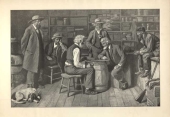The Checker Maven
The World's Most Widely Read Checkers and Draughts Publication
Bob Newell, Editor-in-Chief
Published each Saturday morning in Honolulu, Hawai`i
Contests in Progress:
On the Edge

In today's Checker School installment, we have a position that is literally "on the edge" with nearly all of the pieces starting out on the edges of the board. It's yet another instance where you think the win ought to be clear; after all, Black seems to have real superiority here---- or does he?
We certainly don't call this an easy problem. The win is fairly long and involved and concludes with an elegant tableau, and it might be a bit of a challenge for you to find the solution. Here's the position.
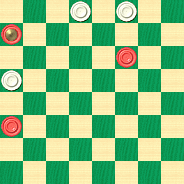
BLACK
White to Play, Black Wins
W:W31,30,20:BK28,22,12.
Can you edge your way to victory, or will you go over the edge instead? There's no need to worry; clicking on Read More will take the edge off your anxieties by bringing you a detailed solution with copious notes, and a sample game as well.![]()
A Souter Six-Shooter

As we continue to republish the unequalled classic Tricks Traps & Shots of the Checkerboard we today find author Willie Ryan ready for a real shoot-em-up. It's one we're sure you'll enjoy. Willie tells us all about it below.

"The ancient Souter opening, formed by 6-9 at the fifth move of the game tabulated below, was a great favorite with all the champions in Wyllie's day. According to historians, the opening was named after a Scottish shoemaker who knew his way around with it. Here's a Souter snare that will shake the crown from any king:
| 11-15 | 24-20 | 10-14---B |
| 23-19 | 15-24 | 19-10 |
| 9-14 | 28-19 | 6-15 |
| 22-17 | 11-15 | 13-9 |
| 6-9---A | 27-24 | 14-18 |
| 17-13 | 14-17 | 23-14 |
| 2-6 | 21-14 | 7-11 |
| 25-22 | 9-18 | 31-26 |
| 8-11 | 26-23 | 12-16---C, |
| 29-25 | 18-27 | forming |
| 4-8 | 32-23 | the |
| diagram. |
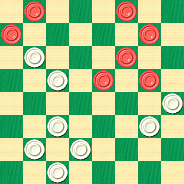
WHITE
White to Play and Win
W:W9,14,20,22,24,25,26,30:B1,3,5,8,11,15,16.
A---The Souter opening, a standard debut leading to an equal game.
B---A good "catch" line for black is 5-9. After this move, 23-18, 8-11, 20-16, 11-27, 18-2, 27-32, etc., leads to a draw; but if white plays 25-21 after 5-9, then black scores with this impressive combination: 5-9, 25-21, 9-14, 21-17 (all that's left), 14-21, 23-18, 8-11, 31-27 (31-26, 3-8 wins), 11-16*, 20-2, 1-5, 18-11, 3-7, 2-9, 7-32, 9-6, 32-28, 6-15, 28-10. W. S. Lambert. A real beauty.
C---Well-known play to here. The text loses by the pending shot. The correct moves are: 3-7*, 25-21, 15-19, 24-15, 11-25, 9-6, 1-17, 21-14, 8-11 *, leading to a draw."
Were you quick on the draw in finding the solution? Don't be blown away; click on Read More to shoot directly to the solution.![]()
What Happened to "Let's Play Checkers"?

We've been promising an ebook version of the classic Let's Play Checkers, by Kenneth Grover and Tommie Wiswell, for some little while now. Here's what's been going on.
First, the ebook edition turned out to be a lot more effort than we expected. We'd rather be late than produce less than a top-quality edition, and typesetting this book is simply taking a lot of time to do right.
But there is another issue, one that we ran into at a fairly late stage in the project. While our initial research indicated that the book was in the public domain, and therefore eligible for reissue by us, we have recently learned that copyright claims had in fact been asserted, and therefore we must now seek permission to republish the book.
We're in the process of trying to locate the copyright claimant, which is difficult enough in and of itself; then we'll need to ask for the necessary releases, something which the claimant may or may not be willing to grant. Under current copyright law, the book won't go into the public domain until the year 2035! (We believe this is excessive and out of tune with the original intent of copyright legislation, but that's another whole topic.)
Of course we're hoping for the best and for a speedy result. We'll keep you informed as we go along.![]()
Win or Draw? It's Fifty-Fifty!

This month in our Checker School column you have a fifty-fifty chance of getting the right answer even if you don't know a thing about checkers! Here's the position we're going to consider.

BLACK
Black to Play
B:WK23,K7,K6:BK17,K13,9.
Only two moves look possible for Black in this tough situation.
Consider: 9-14 loses quickly to 7-2 followed by 6-9, while 17-14 goes down almost as quickly via 6-10 14-17 23-18 17-21 10-14.
That just leaves 17-21 and 17-22.
One of these two allows White to win; it's known as Wardell's Win. The other obtains a draw for Black, and goes by the name Sweeney's Draw. All you have to do is say which is which! So, even if you just guess at the solution, you have even odds of getting it right!
Of course, all of you two-fisted checkerists will undoubtedly want to go on and demonstrate just how the win or draw takes place ... won't you?
Whether you work it all out or just play the odds, there's one sure thing: clicking on Read More will give you the answers, sample games, and explanatory notes, all courtesy of Ben Boland and his classic book Famous Positions in the Game of Checkers.![]()
Thirkell's Folly

It's a "Willie Ryan" Saturday today, as we continue with our electronic republication of his classic Tricks Traps & Shots of the Checkerboard. These monthly excerpts seem to rank among our most popular columns, and with good reason: there was no one else in checker history quite like Willie; a master player who was also a most engaging writer and instructor. Here's what Willie has to say this time.

"Peter Thirkell, a prolific and talented analyst and problemist, held a prominent place as the draughts oracle of 70 years ago. But sometimes Pondering Peter, like the rest of us, pulled glaring boners. Witness his oversight in the following game, in which he passed up one of the most beautiful in-and-out shots ever to adorn the board.
| 10-15 | 29-25 | 11-16 |
| 23-19 | 16-23 | 25-22 |
| 6-10 | 26-19 | 16-23 |
| 22-17 | 8-11 | 27-11 |
| 1-6 | 17-13 | 7-16 |
| 25-22 | 3-8 | 32-27 |
| 11-16 | 22-17 | 10-15---A |
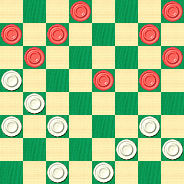
WHITE
White to Play and Win
W:W31,30,28,27,24,22,21,17,13:B16,15,12,9,8,6,5,4,2.
A---Given by Thirkell to draw, but it loses. 8-11 or 16-20 will produce a draw easily."
Fool around with this problem all you wish, but don't be fooled; it's no folly to click on Read More to see the very fine solution.![]()
Symmetry

Checker School today brings us a problem that exhibits a certain form of symmetry; not the perfect symmetry of our photo, to be sure, but nevertheless an appealing geometric pattern. The position is credited to a Mr. Brooks, and looks like this.
WHITE
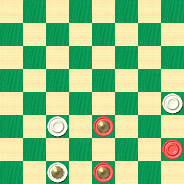
BLACK
Black to Play and Win
B:W13,11,K3:BK10,5,K2.
As it turns out, reflecting our theme of symmetry, Black has not one but two ways of winning. Can you find them both?
Reflect on this for a while, but if you can't mirror the winning thought process, a simple click on Read More will flip to the solution page, which contains the answer to the problem, a sample game, and detailed notes, all courtesy of Ben Boland.![]()
Wyllie's Switcher Swindle
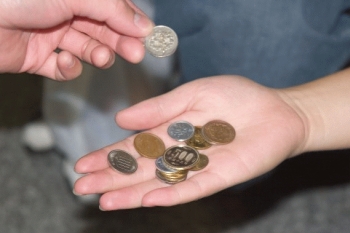
Once again it's time for an installment from one of the greatest checker books of all time, Willie Ryan's Tricks Traps & Shots of the Checkerboard. This month Willie takes us back in checker history, to a stratagem employed by Scotland's legendary James Wyllie. Willie tells us all about it in his own well-chosen words.

"It is impossible to record the historic stratagems of the world's great draughts players without including the hallowed name of James Wyllie of Scotland, father of modern checkers and the game's first full-time professional. Here we review one of the wily Scot's best-known thunderbolts:
| 11-15 | 6-10 | 4-8 |
| 21-17---A | 22-17 | 29-25 |
| 9-13 | 13-22 | 11-15 |
| 25-21 | 26-17 | 30-26 |
| 8-11 | 15-18 | 6-9---B |
| 17-14 | 24-20 | |
| 10-17 | 2-6 | |
| 21-14 | 28-24 |
forming the diagram.
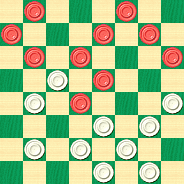
WHITE
White to Play and Win
A---The Switcher opening; weak for white. Champion Wyllie was first to use and develop the gambit, and despite its inherent weakness, he doomed many a master with the white pieces.
B---Caught! White now ends all organized resistance with a neat double-action bust-up. The correct play at B is: 15-19, 24-15, 10-19, 23-16, 12-19, 27-23, 18-27, 32-16, 6-9, 26-22, 9-18, 22-15, 8-12, 16-11, 7-16, 20-11, 3-7, 11-2, 1-6, 2-9, 5-30, ending in a draw."
Will you too be swindled, or can you find your way to the solution? Try it out, but be sure to count your change before clicking on Read More to see how it's done.![]()
Barker's Bounce

As each month we continue to republish Willie Ryan's masterful Tricks Traps & Shots of the Checkerboard, we can't help but notice that the situations presented are, at least in a general sense, increasing in difficulty.
But no matter. We have Willie at our electronic side to explain it all. Here's one he calls Barker's Bounce for reasons that we'll let him explain for himself.

"This useful study shows how Champion G. F. Barker gave the bounce to James P. Reed in their stubbornly fought American Championship battle of 1891. Ever since that time, the losing move at A has been carefully sidestepped by all alert generals of the board.
| 12-16 | 3- 8 | 15-19---A |
| 24-20 | 26-22 | 20-11 |
| 8-12 | 11-15 | 8-15 |
| 28-24 | 20-11 | 23-16 |
| 9-14 | 7-16 | 12-19 |
| 22-17 | 24-20 |
forming the diagram.

WHITE
White to Play and Win
W:W17,21,22,25,27,29,30,31,32:B1,2,4,5,6,10,14,15,19.
A---This is where Reed took the road to ruin. The only move that will produce a draw is: 5-9*, 20-11, 15-18, 22-15, 10-26, 30-23, 8-15, 17-10, 15-19, 23-16, 12-19, 10-7, 2-11, 25-22, 11-15, 31-26, 4-8, etc. Willie Gardner."
Will this problem give you the bounce too, or will you rebound and solve it? In any case you can roll along to Willie's solution just by clicking on Read More.![]()
Horsefall's Stroke

Continuing with our ongoing series taken from Willie Ryan's Tricks Traps & Shots of the Checkerboard, this month we present a complex problem that Willie himself admired greatly, as he clearly states below.

"No compendium of classical coups would be complete without including the historical Horsefall Stroke, which I consider one of the great masterpieces of scientific play. Here's the run-up:
| 11-15 | 4-8 | 14-21 |
| 23-18 | 25-22 | 18-14 |
| 8-11 | 8-11 | 9-18 |
| 27-23 | 29-25 | 22-8 |
| 11-16 | 10-14 | 1-6* |
| 18-11 | 31-27 | 8-4 |
| 16-20 | 6-10---A | 6-10* |
| 24-19 | 19-15 | 4-8 |
| 7-16 | 10-19 | 3-7* |
| 22-18 | 21-17 | 8-11---B |
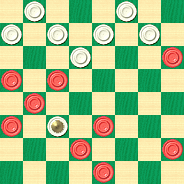
BLACK
Black to Play and Draw
A---Weak, but drawable. The following makes an easier draw: 3-8, 19-15, 2-7, 22-17, 7-10, 17-13, 10-19, 26-22, 19-26, 30-23, 14-17, 21-14, 11-15, 18-4, 9-18, 23-14, 6-9, etc.
B---Strongest, forming position illustrated. If instead of 8-11, white moves 25-22, the only moves to draw are: 7-11*, 8-6, 2-9, 22-18, 9-13*, 18-14, 13-17, 14-10 (23-18, 21-25, 30-21, 19-24 results in a draw), 5-9, 23-18, 9-13, 18-15, 17-22."
We're well beyond the introductory material in Mr. Ryan's classic book, so you can't expect an easy ride. Don't horse around; try to rein in the problem, and then click on Read More to gallop directly to the Willie's solution.![]()
How to Beat Granddad at Checkers

It was our pleasure quite recently to receive in the mail a copy of a wonderful new checker book, John Cardie's How to Beat Granddad at Checkers, and we simply can't say enough good things about it.
Mr. Cardie's book is based partly on the premise that grandparents have a lot to offer to grandchildren, and that many important lessons can be imparted over the checkerboard. So, to a large extent, the book is about much more than checkers: it's about life, and wisdom, and family, and learning, and teaching. It's about precious hours that grandparents and grandchildren can spend together and about the wonderful and irreplaceable memories that these moments create. Mr. Cardie's book speaks to the heart as much as to the mind.
Of course, there's checker content galore, and grandparents will likely learn a great deal themselves. After an introduction which convincingly explains why checkers is a good thing for both grownups and youngsters, Mr. Cardie teaches about the numbered board and checker notation, and then jumps right into basic checker tactics. (Presumably, grandparents can teach the rules and other basics on their own, although there is a later chapter in the book with the official rules of checkers.) Mr. Cardie has invented some very clever new names for old tactics, such as "the sandwich move" for what is traditionally known as "breeches." Some of the names are really catchy, such as "Twins in the Closet" for a particular three king vs. two king endgame. The book as well is liberally sprinkled with pages of general instruction, such as lessons on sportsmanship, and interestingly titled items like "Earnings and Yearnings" and many more, which use checkerboard situations as analogues for life. There are a number of checker puzzles of appropriate difficulty; and a listing of checker websites and resources rounds out the volume.
Some time back, we reviewed Galina Golant's excellent book, Play Checkers With Me. Ms. Golant's book was at the small child, introductory level. Mr. Cardie's book is the next step up, and is suitable for use with children who are a few years older, perhaps from the age of six or seven onwards. But there is no question that adults too will enjoy the book and benefit from it.
We hear that Mr. Cardie may be able to land a national distribution contract for the book through a prominent chain. We're sworn to secrecy about the details, but we certainly hope that comes to pass.

Author John Cardie
Obtaining this book is easy and inexpensive, and something that we recommend you do without delay. Just go to Mr. Cardie's website at www.checkerscreateskings.com for full details on ordering options. It's a book that is not to be missed.![]()
The Checker Maven is produced at editorial offices in Honolulu, Hawai`i, as a completely non-commercial public service from which no profit is obtained or sought. Original material is Copyright © 2004-2025 Avi Gobbler Publishing. Other material is the property of the respective owners. Information presented on this site is offered as-is, at no cost, and bears no express or implied warranty as to accuracy or usability. You agree that you use such information entirely at your own risk. No liabilities of any kind under any legal theory whatsoever are accepted. The Checker Maven is dedicated to the memory of Mr. Bob Newell, Sr.

